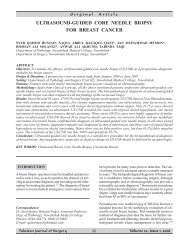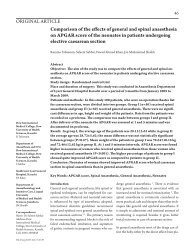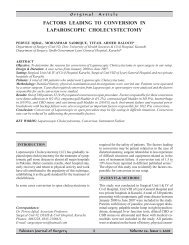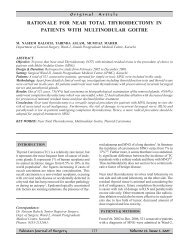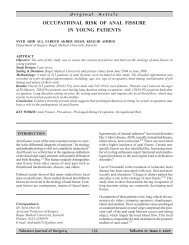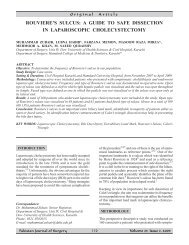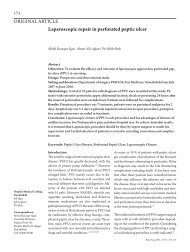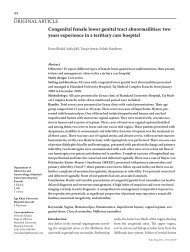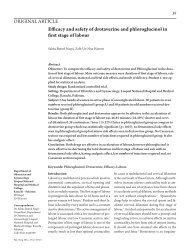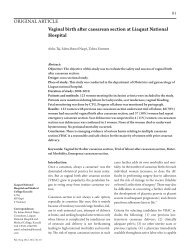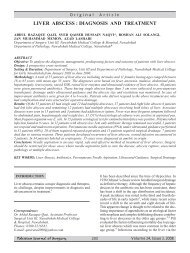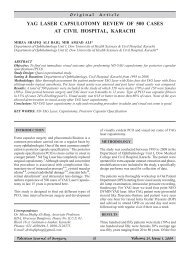Hypocalcemia: A genuine threat after thyroidectomy
Hypocalcemia: A genuine threat after thyroidectomy
Hypocalcemia: A genuine threat after thyroidectomy
Create successful ePaper yourself
Turn your PDF publications into a flip-book with our unique Google optimized e-Paper software.
INTRODUCTION<br />
The postoperative hypocalcemia is frequently observed<br />
within 2-5 days <strong>after</strong> total and subtotal <strong>thyroidectomy</strong>,<br />
requiring exogenous replacement therapy to alleviate<br />
the clinical symptoms. Inadvertent parathyroid excision<br />
and hypocalcaemia are well recognized complications<br />
of thyroid surgery. Theodor Kocher reported first 100<br />
thyroidectomies in 1883 and noted the presence of<br />
tetany in a number of cases. William Halsted (1852-<br />
1922) was one of the first surgeons to advocate meti-<br />
culous surgical technique to prevent damaging the parathyroid<br />
glands and so contributed greatly to the prevention<br />
of this serious complication which, together with<br />
bleeding and laryngeal nerve injury had made early<br />
thyroid surgery so dangerous. 1 In several studies, 2,3 the<br />
incidence of hypocalcemia varied from 1.6% to more<br />
than 50%. Among the potential factors causing decrease<br />
in serum calcium, hemodilution 4 , calcitonin release 5<br />
and “hungry bone syndrome” were implicated in patients<br />
with hyperthyroidism and osteodystrophy. 6 Inadvertent<br />
parathyroid excision (IPE) and hypocalcemia are well<br />
recognized complications of thyroid surgery. 7 The exact<br />
pathogenesis of hypocalcemia in postoperative patients<br />
is difficult to explain. It is, however, varies in different<br />
pathological conditions of thyroid gland and types of<br />
surgical intervention. Graves disease, malignancy, total<br />
<strong>thyroidectomy</strong> and parathyroid gland ischemia / injury<br />
are main causes of lowering of serum calcium concentration.<br />
8 Hypoparathyroidism is an additional event<br />
whereas hypocalcemia is relatively common <strong>after</strong> total<br />
<strong>thyroidectomy</strong>. 9 Transient hypocalcemia is a common
complication of thyroid surgery. Although the long lasting<br />
effects are rare, immediate post operative morbidity<br />
is increased and hospital stay is prolonged. The common<br />
clinical manifestations of hypocalcemia are tetany,<br />
Chvostek’s sign and carpopedal spasm (Trousseau’s<br />
sign). The objective of this study was to determine the<br />
frequency of hypocalcemia following <strong>thyroidectomy</strong>.<br />
METHODOLOGY<br />
It was a Quasi-experimental study conducted at Ward<br />
26, Department of Surgery, Jinnah Postgraduate Medical<br />
Center (JPMC), Karachi. This included all patients<br />
under going any thyroid operation between 1st March<br />
2002 and 31st December 2002. The serum calcium<br />
levels were measured preoperatively. All patients having<br />
serum calcium less then 8mg/dl were considered hypocalcemic<br />
and were excluded. In all, 104 patients underwent<br />
thyroid surgery during the above mentioned period.<br />
All patients were examined for the type of thyroid disease<br />
and previous neck surgery. All operations were<br />
performed by Consultant and Senior Registrar by standard<br />
technique. Parathyroids were attempted to be identified<br />
with naked eye examination and preserved during<br />
surgery. Total thyroid resection for benign diseases was<br />
performed intracapsularly. On first post-operative day,<br />
patients were evaluated clinically as well as biochemically<br />
and patients were allowed regular diet. Data was<br />
collected by filling the proforma post-operatively. The<br />
main outcome variable was hypocalcemia which was<br />
monitored at regular intervals for about two years. The<br />
patients having postoperative hypocalcemia were given<br />
oral replacement therapy and were later followed up in<br />
outpatient clinic at regular intervals for two years.<br />
RESULTS<br />
In all, 104 patients underwent 120 thyroid operations<br />
during the above mentioned period. These included 92<br />
female and 12 male patients. The mean age was 38.5<br />
years with the range of 16 to 50 years. About half of<br />
the patients were having multinodular goiter whereas<br />
37% patients had unilobular disease. About 8% patients<br />
had initial diagnosis of malignant lesion. Lobectomy<br />
was done in 39% patients and similar proportion of<br />
patients underwent subtotal <strong>thyroidectomy</strong>. About quarter<br />
of the patients underwent total <strong>thyroidectomy</strong>. About<br />
42% of the patients undergoing lobectomy were found<br />
to be having malignancy on histopathology of resected<br />
specimen. These patients underwent completion <strong>thyroidectomy</strong>.<br />
The average preoperative calcium level was<br />
8.5mg/dl. The postoperative transient hypocalcemia<br />
was noticed in about 39% of the patients. Transient<br />
hypocalcemia was noticed <strong>after</strong> about 54% of total<br />
thyroidectomies and about 50% of the completion thyroidectomies.<br />
The average fall in serum calcium level<br />
was 0.84mg/dl. All hypocalcemic patients were managed<br />
by oral replacement therapy with calcium supplements.<br />
None of the patients developed permanent hypocalcemia.<br />
The relationship of procedures and transient hypocalcemia<br />
ismentioned in Table I.<br />
DISCUSSION<br />
Postoperative hypocalcemia is a major concern following<br />
thyroid surgery. It often extends the duration of the<br />
hospital stay and the need for biochemical tests and so<br />
significantly increases the overall cost of <strong>thyroidectomy</strong>.<br />
When severe, it can lead to serious complications and<br />
require intravenous therapy to alleviate the clinical symptoms.<br />
10 In this study, postoperative hypocalcemia was<br />
found in 39% of the patients and this correlates with<br />
other studies reporting postoperative hypocalcemia to<br />
be in a few to more than 50% of patients. 10-14 Patients<br />
having hyperthyroidism and thyroid carcinoma are generally<br />
considered at risk for post <strong>thyroidectomy</strong> hypocalcemia.<br />
15 The risk factors for transient hypocalcemia<br />
depend on surgical technique of individual surgeon,<br />
hemodilution and secondary hypoparathyroidism due<br />
to trauma or devascularization. Permanent hypocalcemia<br />
is reported 2% to 33% in various studies. 16-18<br />
No significant correlation between the pre-operative<br />
clinical characteristics of the patients and long-term<br />
outcome of their hypocalcemia was observed. Permanent<br />
hypoparathyroidism is slightly more frequent in cases
of <strong>thyroidectomy</strong> for hyperthyroidism, thyroid carcinoma<br />
or previous neck surgery. The policy of preservation of<br />
parathyroid glands in situ was adopted but strict adherence<br />
to this principle alone may limit the completion<br />
of <strong>thyroidectomy</strong> as well as the lymph node dissection.<br />
The frequency of hypocalcemia was increased by increasing<br />
the extent of thyroid resection. 19 <strong>Hypocalcemia</strong><br />
can occur as a late presentation of progressive atrophy<br />
of the parathyroid glands 20 and these patients may no<br />
longer remain in regular follow up and diagnosis of<br />
hypocalcemia can easily be missed. <strong>Hypocalcemia</strong> may<br />
present with nonspecific vague symptoms and should<br />
be considered in patients having history of previous<br />
thyroid surgery. 21 In local literature, the incidence of<br />
hypocalcemia is reported to be 32% following total <strong>thyroidectomy</strong>,<br />
25.8% <strong>after</strong> near total <strong>thyroidectomy</strong>, 25%<br />
following subtotal <strong>thyroidectomy</strong> and 28.5% following<br />
lobectomy and isthmusectomy. 13 The frequency of hypocalcemia<br />
in hyperthyroidism was reported to be 38%<br />
to 43.8%. 14 The vascularisation of parathyroid gland is<br />
not entirely clear and the studies on the superior and<br />
inferior thyroid arteries with laser Doppler flow meter<br />
indicate that inferior thyroid artery does not play a key<br />
role in parathyroid vascular supply. 22 This study demonstrates<br />
that careful capsular dissection, pre-operative<br />
calcium evaluation, optimization of underlying thyroid<br />
pathological condition and meticulous surgical technique<br />
can prevent post <strong>thyroidectomy</strong> hypocalcemia.<br />
CONCLUSION<br />
The frequency of postoperative transient hypocalcemia<br />
was about 39% and this was observed mostly on the<br />
2nd postoperative day.<br />
REFERENCES<br />
1. Halsted W, Evans H. The parathyroid glandules.<br />
Their blood supply, and their preservation in operations<br />
upon the thyroid gland. Annals of Surgery<br />
1907; 46: 489-506.<br />
2. Jacobs J K, Aland J W, Ballinger J F. Total <strong>thyroidectomy</strong>:<br />
a review of 213 patients. Ann Surg 1983;<br />
197(5): 542-9.<br />
3. Al-Suliman N N, Ryttov N F, Qvist N, Blichert-<br />
Toft M, Graversen H P. Experience in a specialist<br />
thyroid surgery unit: a demographic study, surgical<br />
complications and outcome. Eur Journ Surg 1997;<br />
163(1): 13-20.<br />
4. Demeester-Mirkine N, Hooghe L, Van Geertruyden<br />
J, De Maertelaer V. <strong>Hypocalcemia</strong> <strong>after</strong> <strong>thyroidectomy</strong>.<br />
Arch Sur 1992; 127(7): 854-8.<br />
5. Wilkin T J, Isles T E, Paterson C R, Crooks J, Beck<br />
J. Post-<strong>thyroidectomy</strong> hypocalcaemia: a feature of<br />
the operation or the thyroid disorder Lancet 1977;<br />
1(8012): 621-3.<br />
6. Michie W, Duncan T, Hamer-Hodges D W, Bewsher<br />
P D, Stowers J M, Pegg C A. Mechanism of hypocalcaemia<br />
<strong>after</strong> <strong>thyroidectomy</strong> for thyrotoxicosis.<br />
Lancet 1971; 1(7698): 508-14.<br />
7. Rix T E, Sinha P. Inadvertent parathyroid excision<br />
during thyroid surgery. Surgeon 2006; 4(6): 339-<br />
42.<br />
8. Pattou F, Combemale F, Fabre S, Carnaille B, Decoulx<br />
M, Wemeau J L. <strong>Hypocalcemia</strong> following thyroid<br />
surgery: incidence and prediction of outcome.<br />
World J Surg 1998; 22(7): 718-24.<br />
9. De Falco M, Parmeggiani D, Giudicianni C, Lanna<br />
A, Miranda A, Oliva G. Post-<strong>thyroidectomy</strong>. Personal<br />
experience. Minerva Endocrinol. 2002; 27(3):<br />
215-23.<br />
10. Olson J A, De Benedetti M K, Baumann D S, Wells<br />
S A. Parathyroid autotransplantation during <strong>thyroidectomy</strong><br />
results of long term follow up. Ann Surg.<br />
1996; 223(5): 472-80.<br />
11. Reber P M, Heath H. Hypocalcemic emergencies.<br />
Med Clin North Am. 1995; 79(1): 93-106.<br />
12. See A C H, Soo K C. Hypocalcaemia following<br />
<strong>thyroidectomy</strong> for thyrotoxicosis. Br Journ Surg<br />
1997; 84(1): 95-7.<br />
13. Ahmed A, Khan H M, Choudhary N, Qureshi A<br />
U, Shah T A. Post <strong>thyroidectomy</strong> hpocalcaemiaan<br />
audit of 100 cases. Ann King Edward Med Coll.<br />
2006; 12(2): 285-7.<br />
14. Gann D S, Paone J F. Delayed Hypcalcaemia <strong>after</strong><br />
<strong>thyroidectomy</strong> for Graves disease is prevented by<br />
parathyroid autotrnsplanatation. Ann Surg 1979;<br />
190: 508-13.<br />
15. Mc Henry C R, Speroff T, Wentworth D, Murphy<br />
T. Risk factors for post <strong>thyroidectomy</strong> hypocalcemia.<br />
Surgery 1994; 116(4): 641-7.<br />
16. Bergamaschi R, Becouarn G, Ronceray J, Arnaud<br />
J P. Morbidity of thyroid surgery. Am Journ Surg<br />
1998; 176: 71-5.<br />
17. Dead F, Santini J, Pepino J M. Subtotal Thyroidec-
tomy for multinodular goiter: experiences of 223<br />
cases. Ann Chir 1987; 42: 735.<br />
18. Attie J N, Mokowitz G W, Margouleff D. Feasibility<br />
of total <strong>thyroidectomy</strong> in the treatment of thyroid<br />
cancer. Am Journ Surg 1979; 139: 1166-71.<br />
19. Sianesi M, Del Rio P, Ferreri G, Arcuri M F, Medusei<br />
G M, Robuschi G. Post-<strong>thyroidectomy</strong> hypocalcemia:<br />
clinical and laboratory findings. Chir Ital<br />
2004; 56(2): 169-74.<br />
20. Wade J S H. The mortality of subtotal <strong>thyroidectomy</strong>.<br />
Br Journ Surg 1960; 48: 25-42.<br />
21. Bellamy R J, Kendall-Taylor P. Unrecognized hypocalcaemia<br />
diagnosed 36 years <strong>after</strong> <strong>thyroidectomy</strong>.<br />
J R Soc Med 1995; 88: 690-1.<br />
22. Johansson K, Ander S, Lennquist S, Smeds S.<br />
Human parathyroid blood supply determined by<br />
Laser-Doppler flowmetery. Wold Journ Surg 1994;<br />
18(3): 417-21.



